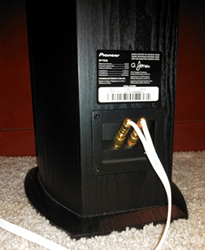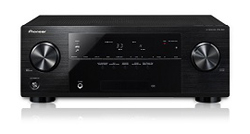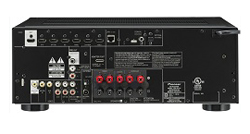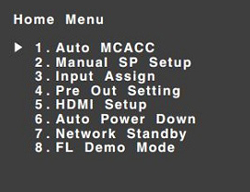
Introduction to the Pioneer SP-PK52FS 5.1 Speaker System and VSX-822-K A/V Receiver
Pioneer. Few brands in consumer electronics are as recognizable and respected. Pioneer has been and remains a leader in myriad aspects of audio and video, from cars to home theater, to personal audio. And while Pioneer is often one of first brands I recommend for A/V receivers, it has not been at the top of my list of speaker manufacturers. It’s not that I would have ever steered someone specifically away from Pioneer speakers (believe me there are some brands I would steer people away from). Rather, I was ambivalent.
In recent years though, Pioneer has brought Andrew Jones of KEF and TAD fame, on board as chief speaker designer, and tasked him with designing a family of high-value, high performing, budget speakers. His first iteration, last year’s 51-series speakers, was a critical success.
For this review, I tested a full 5.1 home theater package including the budget VSX-822-K A/V receiver. I admit, I was most excited to get the chance to review the speakers though, and I was expecting a lot from them. Their predecessors were very highly regarded and the specs and data from Pioneer indicate that this new set should be an improvement over the previous incarnation. Together with the VSX-822 receiver, there is potential for a game-changing $1000 range budget system. I am a sucker for a big bang/buck ratio. I couldn’t wait to get started!
PIONEER SP-PK52FS 5.1 SPEAKER PACKAGE AND VSX-822-K A/V RECEIVER SPECIFICATIONS
VSX-822-K Audio Video Receiver
- Design: 5.1 channel A/V Receiver
- Codecs: Dolby TrueHD, DTS-HD MA and all related surround formats; MP3, WMA, AAC, Apple Lossless, 192kHz / 24-Bit WAV & FLAC via USB and Network; iPod digital audio; HDMI SACD 2-ch
- Power Output: 80 W/ch RMS @ 8 ?, 20-20,000Hz, ? 0.08% THD
- Video Connections: HDMI v.1.4 (6 in, 1 out); Composite (2 in, 1 out)
- Audio Connections: 1x Analog Audio input; 2x Digital Audio inputs
- Other Connections: USB 2.0, iPod (USB + Video); Headphone; front A/V; Ethernet
- Dimensions: 6.7″ H x 17.2″ W x 13.5″ D
- Weight: 19.6 Pounds
- MSRP: $379.99 USD
SP-FS52 Floor-standing Speakers
- Design: Bass-reflex 3-way Tower Speaker
- Drivers: One 1″ Tweeter, One 5.25″ Midrange, Two 5.25″ Woofers
- Sensitivity: 87 dB (2.83V)
- Crossover Frequency: 250 Hz, 3 kHz
- Nominal Impedance: 6 Ohms
- MFR: 40-20,000 Hz
- Power Rating: 130W max
- Dimensions: 35.2″ H x 8.9″ W x 10.6″ D
- Weight: 25.8 Pounds/each
SP-BS22 Bookshelf Speakers
- Design: Bass-reflex 2-way Bookshelf Speaker
- Drivers: One 1″ Tweeter, One 5.25″ Midrange
- Sensitivity: 85 dB (2.83V)
- Crossover Frequency: 3 kHz
- Nominal Impedance: 6 Ohms
- MFR: 55-20,000 Hz
- Power Rating: 80W max
- Dimensions: 12.6″ H x 7.1″ W x 8.4″ D
- Weight: 9.1 Pounds/each
SP-C22 Center Channel Speaker
- Design: Bass-reflex 2-way Horizontal Center Channel Speaker
- Drivers: One 1″ Tweeter, Two 4″ Midrange
- Sensitivity: 88 dB (2.83V)
- Crossover Frequency: 3 kHz
- Nominal Impedance: 6 Ohms
- MFR: 55-20,000 Hz
- Power Rating: 90W max
- Dimensions: 18.1″ H x 7.1″ W x 8.4″ D
- Weight: 13.4 Pounds
SW-8MK2 Powered Subwoofer
- Design: Down-Firing, Ported Enclosure
- Driver: One 8″
- Crossover Frequency: 38 – 150 Hz Adjustable
- MFR: 38 – 150 Hz
- Power Rating: 100W (50 W FTC)
- Dimensions: 12.2″ H x 14.2″ W x 12.2″ D
- Weight: 20.3 Pounds
- SP-PK52FS System
- MSRP: $549.99
- Pioneer
- SECRETS Tags: Pioneer, Speakers, 5.1, Receivers, Audio
Design of the Pioneer SP-PK52FS 5.1 Speaker System and VSX-822-K A/V Receiver
This system comes in five speaker boxes. I opened the center channel first. The build of the center speaker is very solid, although slightly lighter than I thought it would be (given my expectations). Knocking on the cabinet of the speaker yields a solid wooden thud with a nice low harmonic emanating from the ports. Speaker wire binding posts on the speaker are of high quality. This is always a bit of a relief. While it’s becoming less common, I’m always a bit wary of budget speakers, fearing they may come with the dreaded “spring clips”.

The “stand” for the center channel is ingenious: The upper and lower surfaces of the speaker are curved. Thus the speaker would rock front to back if you just lay it on a hard surface of any kind. Included are two thin rubber strips each curved to match the cabinet curvature. Simple. Easy. Effective.
The build quality is the same for the entire set. The front towers are especially impressive: solid, quality construction, dual ports… I had to keep reminding myself that this is a budget system, as I unpacked everything. One slight oversight with the towers was the omission of spikes. I have carpeted floors in my HT room, and would have appreciated a set of spikes to give the towers a more stable, solid footing. As it is, they have a nice wide platform, but they feel a bit wobbly on carpet. That said, one nice new touch for this year’s model is that all five speakers have a removable grille for those who prefer the “naked speaker” look once in a while.

Aesthetically, the SP-PK52FS speakers fall a little short. The black faux wood grain finish of the speakers is acceptable, but nothing to write home about, and the speakers themselves are all quite large. While this bodes well for sonic performance, it is cause for concern when thinking about how these will integrate into a room. The center channel especially is of concern, since it has to sit somewhere very close the TV. For smaller rooms that may have the TV sitting on a low stand or table, the center speaker may be more conspicuous that you’d like. Also Pioneer has gone the Henry Ford/Model T route for color choices with these speakers: any color you want, so long as it’s black. A couple of wood color choices may have helped with the aesthetics.
All five speakers and the subwoofer feature a ported design. The towers have dual ports, while the other models have a single ported design. The cabinets are built from what appears to be MDF with a vinyl faux-wood finish. The sides of the speakers are curved, rather than the traditional box shape so many speakers have. Pioneer claim this gives the speakers more stiffness and thus better sound, as well as being more aesthetically pleasing. While I’m not convinced you couldn’t design a rectangular or trapezoidal cabinet that was as stiff as these, I do agree that they look better than a typical rectangular box design. The curved sides could pose a bit of a challenge for some speaker stands though; many of which are designed to grab the (typically parallel) sides of satellite and bookshelf speakers.
The VSX-822-K receiver was fairly standard fare for the price point.

It’s a very nice-looking receiver with a common black brushed front plate and glossy display. Around the back there were surprisingly few connections. Thankfully, nice binding posts for 5 amplified channels were among them, as well as six HDMI inputs, and a single HDMI output.

The weight of the VSX-822 was on the light side, as expected for a receiver at this price. The remote was decent, but not excellent. It was small and light, and the buttons were small and closely spaced. If I owned this receiver, I would replace it with my Harmony remote.
Setup and Calibration of the Pioneer SP-PK52FS 5.1 Speaker System and VSX-822-K A/V Receiver
Although Pioneer sent me the VSX-822 AVR for use with these speakers, I decided to do initial listening with my own receiver, so as to minimize the number of changes in my system and consider the speakers on their own. Initially I just quickly set up the speakers manually on my Yamaha reference receiver. I used them for regular, everyday listening (nothing critical) for about a week. During this time, I was impressed with the general sound of the Pioneer speakers, but not yet overwhelmed. That came a week or so later when I fully calibrated and demoed the system. By this time also, the speakers had some use and were thus well broken-in. After a proper calibration these speakers really came alive. But more on that later.
I found the setup of the VSX-822-K receiver to be fairly straightforward. Although I must admit I had to resort to the manual to figure out how to cancel the “demo mode” that the receiver is stuck in when you first turn it on (hint: run the MCACC calibration). Yes, the VSX-822 includes a fairly basic incarnation of Pioneer’s MCACC auto-calibration software. It has only one memory setting for calibration, so it’s not as easy to play with different setups of furniture and speaker locations as it would be with two or more memory settings. Also this version of MCACC only allows for one listening position. The mic wire was not quite long enough for my room. Granted, my listening position is far — about 19 feet — from my TV and receiver, but it would have been nice if Pioneer made the wire a bit longer. Fully taught, the mic wire barely reached my couch. Anyway, the setup was easy and quick, and for the most part, effective. The MCACC did a fine job of automatically detecting the speakers’ size, position, distance, phase, and setting levels. At some price points, MCACC measures room acoustics and applies complex equalization to achieve a desired room response, be it flat, or “natural”, etc. None of those options are available on this model, so if this version of MCACC is doing the same kind of work behind the scenes, you don’t know it, and you aren’t allowed to tweak it or choose from various room response curves. Regardless, although the tweaker in me wants more control over — or at least knowledge of — the room EQ, the resulting calibration was pleasing.
Both MCACC and YPAO recognized the FS52 tower speakers as “large”, or full-range, speakers. That speaks well to the frequency response of the towers, and brings me to an important point about this system and how to set it up. Even though the towers have decent low-end response (much better than most speakers in this price range), and even though the auto-calibration systems (both Pioneer’s and Yamaha’s) identified them as “large” speakers, it’s still very important to set them as “small” speakers and assign a reasonable crossover frequency (e.g. 60 to 80Hz). This way the amplifier in the subwoofer relieves the amplifiers in the main receiver from having to amplify those lower frequencies which demand so much power. This is nothing new: the concept of and reasons for the sub/satellite audio system have been around for decades. But this hobby (thankfully) continues to get an influx of new members each year, and these speakers in particular I suspect will likely be picked up by newer hi-fi enthusiasts who may be tempted to go ahead and set these speakers up as “large”. I’ll touch on the details more later, but my advice is to resist the temptation, set the towers as small with a crossover in the 60-80Hz range.
The rest of the setup (video & audio connections) was standard and straightforward. The VSX-822 has no component video inputs or outputs, just HDMI and analog composite video. It also has no video converter for analog video to HDMI, so if you do have any analog video sources, you’ll need to run a composite video cable from the receiver to your TV (in addition to the HDMI cable for your digital sources). The VSX-822’s setup menu system is pretty bare-bones

Although I suppose I’d rather have a manufacturer trim expenses by using a plain & simple graphical menu than by reducing features or performance. Speaking of performance . . .
The Pioneer SP-PK52FS 5.1 Speaker System and VSX-822-K A/V Receiver In Use
As I mentioned earlier, my initial audition of the SP-PK52FS speakers was done using my own reference receiver, the Yamaha RX-A2000. I tried the Pioneer speakers in a few different configurations including with the Pioneer sub, with my own SVS 20-39pci sub, and without any sub at all both with my Yamaha receiver and with the Pioneer VSX-822. For each scenario, I ran a full calibration of the system. This wasn’t a matter of simply unplugging a sub, then plugging it back in. When demoing the system without a sub, the SP-FS52 towers were set to “large” so that all low frequency sounds would be routed by the receiver to the front left & right channels.
I started out with the Pod-Race scene from the blu-ray edition of Star Wars Episode I: The Phantom Menace. This scene is filled with a good amount of full-range effects, including Sebulba’s pod with a very thunderous engine. The Andrew Jones designed Pioneer speakers performed wonderfully. The action was enveloping, yet details were not lost. Full-range front-to-back pans were seamless: the timbre was constant as the pod racers flew in and around the canyons of Tatooine. These days, due to family requirements, my standard HT speakers are very small, high quality satellites. Boy was it fantastic to listen to a set of quality speakers with solid frequency response a full octave (or more, in the case of the towers) below my norm.
Next up was the hospital explosion scene from The Dark Knight. I love to crank this scene for low frequency effects demos. Obviously, a good subwoofer will dominate any speaker system with a scene like this, which isn’t the point here. What was interesting with this system — and it was true across the board not just for The Dark Knight — was comparing these speakers with and without the Pioneer SW-8MK2 sub, both on my own receiver and on the VSX-822.
The Pioneer sub has a rated low-end extension virtually identical to that of the SP-FS52 tower speakers it supplements (38Hz for the sub, 40Hz for the towers). So in theory, with the system properly set up and balanced, and with enough power driving the speakers, one shouldn’t really hear much of a difference between these speakers in a 5.1 configuration with the SW-8MK2 or a 5.0 configuration (sans sub). Sure enough, when driven by my more powerful receiver, the differences with and without the Pioneer sub were small. However, when driven by the VSX-822, which has a smaller power supply and less power than my receiver, the differences were definitely noticeable. When driven to loud levels, the sound was less clear, less vibrant; it was more muddied without the subwoofer. At softer volumes, the differences were again hardly noticeable. Low end extension was pretty much the same whether the Pioneer sub was present or not. But using it, and setting up the system properly with it, gave the whole system that much more power and headroom; it was more dynamic. A sub with a dedicated amplifier with its own power supply goes a long way when dealing with a moderately powered receiver. Keep in mind also that all five speakers have a nominal impedance of 6 ohms, meaning the amplifiers have to work even more than with more typical 8-ohm speakers.
Finally, not to beat a dead horse, but I tried one more scenario in this vein: I let the MCACC auto-calibration system detect the towers as “large” and left them that way (whereas in the other scenarios I set them as small with an 60Hz crossover). This resulted in the same, somewhat muddied sound at high volumes as when I setup the system without a sub. It wasn’t quite identical, but definitely not as good as setting the towers to “small” and using a proper crossover setting. Don’t get me wrong – the VSX-822-K is a capable receiver, and a very good value. But it would be easy to not get that impression if it wasn’t set up properly with speakers like these. Set up properly, you can really crank this system. Set it up improperly though, and you may experience buyer’s remorse.
Moving on from movies to music, I dropped in my favorite symphony: Beethoven’s 9th played by the Berlin Philharmonic under the direction of Leonard Bernstein. It’s ideal for audio testing because it contains nearly the full dynamic range of classical music, including choir and operatic vocal soloists. The Pioneer system again performed great. This is not the sound you expect from a $600 set of speakers, especially when it’s a set of five and a sub. Granted, I prefer to listen to classical music in 2.0 stereo mode, but I also demoed the system with Dolby Pro Logic II Music mode, which is a wonderful DSP for music. Vocals were pure and realistic with no sibilance and excellent dynamics. The second movement with the timpani alternating with the orchestra was reproduced quite well. In this case, the differences between the system with and without the sub were less dramatic. The two tower speakers are very musical and nearly sufficient by themselves. Again, the sub doesn’t add much in the way of low-end extension, and few people are inclined to listen to classical music at the levels required to make the receiver start to sweat.
Finally, I cued up a little 1970s pop rock, with my DVD-Audio disc of Fleetwood Mac’s “Rumors” album. This is a high resolution 5.1 channel re-mix of the original album masters. The presentation is very laid-back for surround sound, meaning the rear channels are largely producing ambiance. Again, this very affordable system delivered in spades. As a singer, I tend to focus on the vocals a lot, and I felt very comfortable listening to this vocals-heavy album through the Pioneer system. My standard satellite system is excellent when it comes to imaging, which is why I was surprised at how pleased I was with the imaging of a set of such large speakers. I sat back with my eyes closed and felt like I could locate each band member.
At first I thought my non-iOS, non-HTC, Android phone would not be supported for an AVR controller app. Then I noticed a small sticker that says “ControlApp for iPhone / Android” in small print on the receiver. I found it on the Google Play site, installed it on my Android phone, and it worked great. It’s a very nice AVR controller app. I could browse and play my server’s media, select surround modes, control volume; all the standard things. I don’t know why Pioneer doesn’t tout their Android compatibility more, but they should. You can’t stream music from your Android device to the receiver via this control app, but other than that it worked quite well.
Pioneer included a Bluetooth adapter (AS-BT200) and a WiFi adapter (AS-WL300) in the box with the receiver. Both are sold separately, and I did not test either adapter. The BT adapter would allow you to stream media from your BT enabled Android (or other) device to the receiver. Seems to me like it would be easier to just incorporate this with the ControlApp they already have and ditch the Bluetooth adapter. The WiFi adapter would be very handy if you don’t have a router near your receiver; my router is right next to my HT stack, so this wasn’t an issue.
The Pioneer SP-PK52FS 5.1 Speaker System and VSX-822-K A/V Receiver On the Bench
The only bench testing done for this review was on the video section of the VSX-822-K receiver. To put it succinctly, I was surprised at how well this little receiver did on our video tests: it received a perfect score, achieving as close to actual “pass-through” of an hdmi signal as we can test for. It seems that this is finally becoming more common: fewer receivers muck up the HDMI signal these days. Nonetheless you never know what to expect with the mid-to-low price range, and I was very pleased that the VSX-822-K passed the video signal virtually untouched. I also threw in my 3D Blu-ray of How to Train Your Dragon to verify the 3D capability of the receiver, and it played fine, with no hiccups in the 3D image.
Conclusions about the Pioneer SP-PK52FS 5.1 Speaker System and VSX-822-K A/V Receiver
Both the VSX-822-K A/V receiver and the SP-PK52FS 5.1 speaker package are each excellent bargains in their own right. Together, this is the home theater starter kit to beat. The receiver is mostly no-frills, but does all the essentials quite well, and does include several networking and wireless features and apps to boot. The speakers are really phenomenal considering their price. The subwoofer leaves a little to be desired in the low-frequency range though: with a -3dB point at 38Hz you’re leaving off the last 5 or so keys of a standard piano. But it does well the important job of lightening the load on the receiver’s amplifiers. If you have a higher power receiver, or a decent sub already, I would recommend buying this system piecemeal without the sub. If you’re starting from scratch and are on a budget, you can’t go wrong with the whole 5.1 system. Set it up properly and you will have one rocking home theater with very little cash gone from your coffers.




